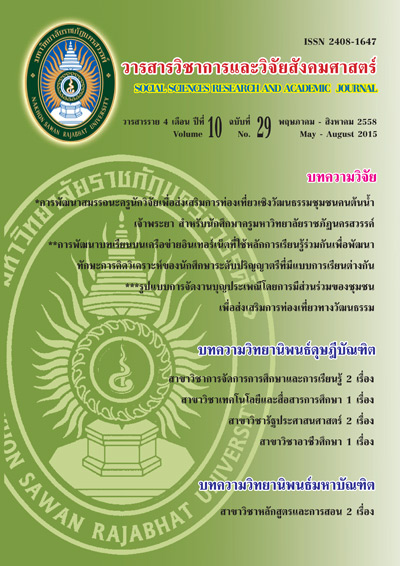การพัฒนาบทเรียนบนเครือข่ายอินเทอร์เน็ตที่ใช้หลักการเรียนรู้ร่วมกันแบบสืบเสาะหาความรู้เพื่อพัฒนาทักษะการคิดวิเคราะห์ของนักศึกษาระดับปริญญาตรีที่มีแบบการเรียนต่างกัน;A Development of Web-based Instruction by Using Collaborative Learning to Develop Analytica
Main Article Content
Abstract
บทคัดย่อ
การวิจัยครั้งนี้มีวัตถุประสงค์เพื่อ 1) ศึกษาปัญหาและความต้องการของผู้สอนและนักศึกษาในเรื่องการใช้
สื่อเทคโนโลยีในการเรียนการสอน 2) สร้างและพัฒนาบทเรียนบนเครือข่ายอินเทอร์เน็ตที่ใช้หลักการเรียนรู้ร่วมกันเพื่อพัฒนาทักษะการคิดวิเคราะห์ของนักศึกษาที่มีแบบการเรียนต่างกัน 3) ทดลองใช้บทเรียนบนเครือข่ายอินเทอร์เน็ต
4) ประเมินบทเรียนบนเครือข่ายอินเทอร์เน็ต กลุ่มตัวอย่าง ได้แก่ นักศึกษาในระดับปริญญาตรี สาขาวิทยาศาสตร์ทั่วไป ชั้นปีที่ 3 คณะครุศาสตร์ มหาวิทยาลัยราชภัฏชัยภูมิ ภาคเรียนที่ 2 ปีการศึกษา 2556 จำนวน 62 คน ที่ลงทะเบียนเรียนวิชานวัตกรรมแห่งการเรียนรู้ EDUC 104 ซึ่งได้มาโดยการสุ่มแบบแบ่งกลุ่ม (Cluster Sampling) โดยใช้ห้องเรียนเป็นหน่วยในการสุ่มผลการวิจัยพบว่า
1. ปัญหาและความต้องการของผู้สอนและนักศึกษาในเรื่องการใช้สื่อเทคโนโลยีในการเรียนการสอน จำแนกเป็น 6 ด้าน คือ 1) ด้านเนื้อหาบทเรียนยังไม่ครอบคลุมเนื้อหาในรายวิชาที่นักศึกษาได้ลงทะเบียน 2) ด้านรูปแบบการจัดการเรียนการสอน จัดการเรียนการสอนจากอาจารย์โดยตรง และการเรียนแบบผสมผสานกับการเรียนผ่านบทเรียนออนไลน์ 3) ด้านการจัดกิจกรรมการเรียนการสอน นักศึกษาและอาจารย์ไม่ค่อยมีส่วนร่วมในการดําเนินกิจกรรมการสอนวิชาที่จัดการเรียนการสอนผ่านอินเทอร์เน็ต 4) ด้านการใช้สื่อและอุปกรณ์ นักศึกษายังใช้บริการการเรียนการสอนผ่านอินเทอร์เน็ตไม่ได้ 5) ด้านการวัดและประเมินผล ยังไม่มีการวัดผลการประเมินในระบบการเรียนผ่านอินเทอร์เน็ต และ 6) ด้านจํานวนรายวิชาที่เปิดการเรียนการสอนผ่านอินเทอร์เน็ต ยังไม่ได้เปิดทําการสอนบทเรียนออนไลน์ในทุกรายวิชา
2. บทเรียนบนเครือข่ายอินเทอร์เน็ตที่ใช้หลักการเรียนรู้ร่วมกัน ประกอบด้วย 8 ขั้นตอน ดังนี้ 1) การนำเข้าสู่บทเรียน 2) เสนอปัญหา 3) กำหนดสมมุติฐาน 4) การสำรวจสืบค้นและรวบรวมข้อมูล 5) ขยายความรู้เสริมความรู้ความเข้าใจ 6) วิเคราะห์ข้อมูลและจัดประเภทเพื่อประเมิน 7) สรุปเป็นความรู้ใหม่ และ 8) การวัดและประเมินผล ประสิทธิภาพบทเรียนบนเครือข่ายอินเทอร์เน็ตที่ใช้หลักการเรียนรู้ มีค่าประสิทธิภาพระหว่างเรียนและหลังเรียน
(E1/ E2) ตามเกณฑ์ที่ตั้งไว้ คือ 80/80 โดยมีประสิทธิภาพ เท่ากับ 84.81 / 81.13
3. หลังจากเรียนรู้โดยบทเรียนบนเครือข่ายอินเทอร์เน็ตที่ใช้หลักการเรียนรู้ร่วมกัน พบว่า ผู้เรียนที่มีแบบการเรียนแบบอเนกนัย แบบซึมซับ แบบเอกนัยและแบบปฏิบัติ มีคะแนนทักษะการคิดวิเคราะห์หลังเรียนแตกต่างกันอย่างมีนัยสำคัญทางสถิติที่ระดับ .05
4. ความพึงพอใจของนักศึกษาที่มีต่อบทเรียนบนเครือข่ายอินเทอร์เน็ตที่ใช้หลักการเรียนรู้ร่วมกัน โดยภาพรวม นักศึกษามีความพึงพอใจอยู่ในระดับมาก
Abstract
The purpose of the research was 1) to study the problems and needs of teacher and students in using technology for learning and using web-based Instruction, 2) to develop a web-based Instruction by using collaborative learning to develop analytical thinking skills of students with the different Learning Styles, 3) to implement a web-based instruction by using collaborative learning to develop analytical thinking skills of students with the different learning styles, and 4) to evaluate a web-based instruction by using collaborative learning to develop analytical thinking skills of students with the different learning styles. Sample group used in the study comprised 62 under graduate students in Chaiyaphum Rajabhat University in the second semester of academic year 2013, using cluster random sampling. The results showed that:
1. The problems and needs of teachers and students in using technology for learning and using web-based instruction in Chaiyaphum Rajabhat University are in 6 Categories: 1) The lesson content does not cover all the material in the course the student has enrolled; 2) The forms of teaching. They are taught by teachers directly, and blended with learning through online lesson; 3) The activity of teaching. students and staff have rarely been involved in the activities taught in the courses via the internet; 4) The use of media and devices. Students can not gain access to the course through the internet; 5) The measurement and evaluation. No measure to assess the learning system through the Internet, and 6) The number of courses taught through the Internet. Still no teaching-learning of all subjects.
2. Web-based Instruction by Using Collaborative Learning are in 8 steps: 1) Introduction to the lesson. 2) Presentation of the problem. 3) The hypothesis. 4) Survey research and data collection. 5) Expand awareness, strengthen cognitive knowledge. 6) Data analysis and classification to evaluate. 7) Summary of the new knowledge. 8) Evaluation and assessment of learning. The Efficiency of web-based instruction by using collaborative learning to develop analytical thinking skills of students with different learning styles are E1/E2 equals to 84.81 / 81.13.
3. There was statistical significance difference in analytical thinking at the .05 level among learners from Divergent, Assimilative, Convergent and Accommodative Collaborative Learning Web-based Instruction.
4. Graduate students in Chaiyaphum Rajabhat University have satisfaction at a high level in Web-based Instruction by Using Collaborative Learning to Develop Analytical Thinking Skills of Students.


